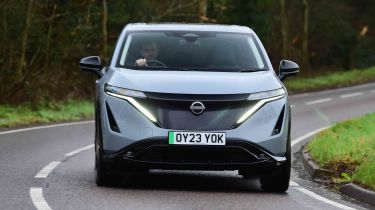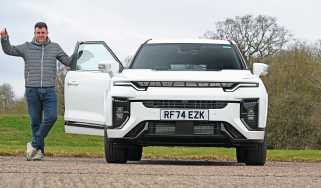Nissan Ariya - Electric motors, performance & drive
As well as offering excellent family SUV credentials, the Nissan Ariya is good to drive and provides decent pace

Despite being a relatively tall and heavy electric SUV, the Nissan Ariya has been engineered to deliver a surprisingly decent drive. It manages to balance offering more accurate handling than many of its close rivals, with the need to provide the comfortable ride expected of an SUV designed for family life. The Ariya’s battery pack is positioned under the centre of the car, helping to create a low centre of gravity and a near-equal front-to-rear weight distribution. This means the Ariya feels more agile than expected, and the light but precise steering adds to this impression.
You can always feel the hefty kerb weight (around 1,950kg for the 63kWh battery, front-wheel-drive cars and 2,220kg in the 87kWh 4x4 models) when you try to drive quickly, and the Ariya isn’t as fun to drive as the more dynamic Kia EV6. The Nissan has the advantage of being more comfortable and refined, though.
Switch the drive mode to Sport, and the throttle set-up becomes noticeably sharper while the steering gains a lot of weight. You also get a loud simulated powertrain whine like a sci-fi flying saucer, and the whole experience isn’t really in keeping with the Ariya’s strengths. We think it’s best to keep it in the more comfortable settings.
|
Model |
Power |
0-62mph |
Top speed |
|
Nissan Ariya 63kWh FWD |
214bhp |
7.5sec |
100mph |
|
Nissan Ariya 87kWh FWD |
239bhp |
7.6sec |
100mph |
|
Nissan Ariya 87kWh AWD |
302bhp |
5.7sec |
124mph |
|
Nissan Ariya 87kWh AWD Nismo |
429bhp |
5.0sec |
124mph |
What is the Nissan Ariya like to drive?
In town
Driving in and around town is pretty effortless, thanks mainly to the accelerator that responds smoothly to inputs, plus the Ariya can move seamlessly between its brake regeneration system and mechanical braking. There’s no jerkiness or uncomfortable jolts as you slow to a stop, which is a real plus point when driving in heavy traffic.
On A- and B-roads
The Ariya’s suspension is more than accomplished at dealing with the typical imperfections of UK roads. Bigger bumps can send shudders through the car, but on half-decent surfaces, it’s good at cosseting its occupants - even on the larger 20” wheels - compared to the average electric SUV. The firm set-up helps keep body roll in check unless you up the cornering speeds, plus there’s plenty of grip to allow you to tackle B-roads confidently.
On the motorway
Long motorway journeys are a breeze in the Nissan Ariya. It’s a very composed and refined cruiser with little wind noise and not too much roar from the tyres. The steering is well-judged to make it effortless to track straight at speed and stay in your lane without frequent adjustment.
0-62mph acceleration and top speed
The entry-level 63kWh model delivers 214bhp and 300Nm of torque from the single electric motor driving its front wheels, which allows it to manage the 0-62mph benchmark in a reasonable 7.5 seconds. Upgrading to the 87kWh battery gets you a stronger 239bhp electric motor, which helps mitigate the negative effects of the extra weight of a larger capacity battery pack. However, acceleration is still slightly impeded, because 0-62mph is dispatched in a marginally slower time of 7.6 seconds.
If you’re prepared to spend over £50,000 on your family wheels, then you might want to consider the 302bhp all-wheel drive Ariya e-4ORCE. These Ariyas generate 600Nm of torque and can rocket from 0-62mph in 5.7 seconds, with a 124mph top speed. If that’s not enough, though, the e-4ORCE Evolve+ ups the power to 389bhp, further reducing the 0-62mph sprint time to 5.1 seconds. Those looking for the ultimate Ariya can go for the Nismo version with 429bhp and a 5.0 second 0-62mph sprint time.








